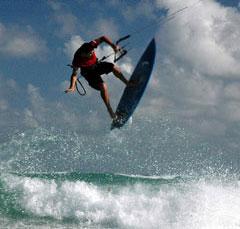![]()
With more and more dedicated riders adding surfboards as piece of their favorite kiting equipment, we decided to take a close look at why a board that originally had nothing to do with the sport is growing so rapidly in popularity.
Function Rules
Strapless riding has been around for years. The craze began with wakeskates and surfboards in late 2001. While the wakeskate came and went quickly, surfboards have endured the long run. The main reason surfboards are still being used and gaining popularity is that they extend the windrange of rider’s existing kites and they are also fun to ride in junk conditions – when you normally wouldn’t go out kiteboarding or surfing.

The surfboard is one of the most versatile tools in kiteboarding. It provides the greatest windrange of all the board choices and lets you have a great time in shitty wave conditions. -Colin Gowland
If you are riding a messy wind swell wave you can make huge closeout sections, and do never ending floaters that would not be possible when surfing without the kite. -Jason Slezak
Misconceptions
The recent surfboard craze has led to misconceptions of what to ride in order to reap the benefits of this new trend. Many riders are digging out their circa ’99 kiteboarding directionals, or ordering up a custom “mini-chip” surfboard/kiteboard look-a-like with no float or drive. Let there be no misunderstanding – to get the extra windrange and keep your kites sub 20m, you need to look at straight out surfboard shapes and sizes. Once you start shaving the board down smaller than 5’6”, you lose the surfboard feel, float, drive and windrange. When this happens, you are at the mercy of the pull of your kite and will have no more drive from your “surf style” board than you do from your existing kiteboard. Your old directional won’t due either. Mainly because it is narrow, with little rocker and a very straight outline. This leads to a board that won’t turn well or fit into the pocket of wave where all the fun is.
Surfboards for Kiteboarding
The problem to date with existing surfboards is that most of them are made of clark foam and polyester resin – a construction barely strong enough for classic paddle surfing- never mind the abuse of kiteboarding. Ride one of these and you will dent it up in a day and break it in half in a month. The new generation of production, epoxy sandwich surfboards are the modern solution to this denting/breakage problem and also come out 30% lighter than most clark/polyester boards. They don’t heel dent, float high in the water, and they have a very tight responsive feel. If you do put your harness hook through them, they don’t take on water either. Make sure to use epoxy resin when repairing them. If you use polyester resin, you will melt the core of the board.
Many kiteboard companies including Jimmy Lewis, Slingshot, and Liquid Force are releasing production surfboards in this type of construction specifically designed for kiteboarding. Many of these boards will hit the market early this season with options for both strap or strapless riding on one board. Kiteboard designers with surf backgrounds and ocean based team riders will assure these boards work perfectly for their application.
I can take my 13m kite to the beach with the surfboard and have a good session if there is wind 90% of the time. The windrange of this combination is amazing. -Colin Gowland

Strapless – Can I do it?
Can you ride strapless? Is a surfboard for you? Most people over estimate the ability or conditions needed to reap the fun of a good surfboard session. They are no harder to ride than most strapped kiteboards, rage upwind, turn well and allow for huge errors in kite positioning due to their added volume. The key to riding them well is always keeping the kite low when riding and keeping your shoulders out and ass in. If you stick your butt out to edge, you’ll get ripped off the board pretty quickly and say strapless is not for you. If you have good riding form with your shoulders out, keeping the board edging between you and the kite, you’ll have no problem speeding around on a surfboard in and out of the surf. This has been the case with everyone I have seen try them for the first time. If they have good form on a kiteboard, they have no problem riding a surfboard the very first session.
If I am riding a normal sized kiteboard in the ocean, I spend double the time going upwind compared to when riding a surfboard. That means half the time riding waves and really having fun. -Colin Gowland
As far as conditions go, you can ride in less wind, and ride far more aggressively in soft, weak conditions. In conditions that you wouldn’t even ride, you can be staying upwind and turning all over small surf. Surfboards transform 1 ft onshore surf with 12 knots of wind into some of the best sessions of the year.
Riding a surfboard with a kite opened up so many sessions when I would have been sitting on the beach not riding because it was too light. -Jason Slezak
Size Matters
What size should you ride? To start out, any size will do. I’ve seen people riding 5’6” thrusters all the way to 9’ longboards. When you’re on the hunt to purchase a board for kiting don’t make the mistake of trying to get a board that will work well for both kiting and surfing. Most riders will end up looking at a board too large if you go this route. You’ll end of kiting with the board a hundred times to every one time you surf it, so go small as it will work much better for kiting. If you do end up surfing it once or twice, you’ll catch a few waves on it and be stoked you can.
I travel with a 6’0″ x 20″ x 2 1/8″, so that I only have to carry one board to both classic surf and kite surf with. I like to ride with a Dakine deck pad in the back and “stickey bumps” wax on the rest. DO NOT use a leash! -Jason Slezak
The sizes that have been working best are 5’8” up to 6’0”. Any larger and the board is bouncing everywhere. Any shorter and you start losing drive on the wave plus your windrange is reduced. Width seems to be a good thing as it gives the board more stability for strapless riding, more windrange and flat decks give you a solid, confident feel. I’m 6’2” x 210lbs and the board I ride is 6’ x 20”. Colin Gowland weighs around 170lb and rides a 5’8” x 18.5”. Whenever I rode something larger like a 6’4” or 6’8” it felt too big and long. For the three or four times I surfed a shortboard last year, the 6’0” got me out there and caught some waves. I would have caught more on a larger board, but the larger board would have sucked for kiting the 100 days I kited with that same board.
I like riding a 5’8″ around 18 inches wide with one traction pad on the tail and one up around where the front foot goes with wax in between the two. That way I don’t have to wax up the front foot spot every time I want to ride. -Colin Gowland

Strapless Air?!
Most riders and spectators are blown away to see people riding and surfing surfboards behind the power of a kite. Especially with no footstraps. When these same riders take to the air, most jaws drop to the ground. The top surfboard riders are getting as much as 10 feet of air off waves and kickers. They are able to keep the board on their feet by tilting it into the wind, by unweighting and allowing the board to follow them into the air, or by grabbing the board (nose, indy, etc) . When you see a good surfboard rider launch a strapless jump off a wave and land clean, you begin to wonder if there are any draw backs at all of losing the straps.
“I have not had as much fun launching 2′ – 8′ airs and grabbed airs since I learned to jump!! -Jason Slezak
Getting Started
The easiest way to get started riding a surfboard is on flat water with lighter wind. With familiar conditions like these, learning the basics is an easy and fun experience. You don’t want to be overpowered and can usually get away with at least a full size smaller kite compared to a regular kiteboard.
“Even if you only ride in flat water, a surfboard can make any boring light wind day fun and challenging again.” -Jason Slezak
After mastering flat water, take a session in small surf with side or sideonshore winds. You will be amazed at the power the surfboard generates in small gutless surf. You’ll feel like a 90 pound Florida surf grommet!
Larger Surf
As you become comfortable in the surf, you’ll crave larger and larger waves on the surfboard. All while riding smaller and smaller kites. In the end, it’s a close sibling of tow surfing as you use the kite to get around the break and on to the waves, then just use the shape and speed of the surfboard to ride the wave with the kite generating little or no power at all.
“Nothing can touch it on big clean waves! You are able to go tow surfing without a ski and then still have the power of the kite to get you out of the way when you need to.” -Jason Slezak

Written by Trip Forman the co-founder of REAL Watersports in Cape Hatteras, North Carolina. Jason Slezak coaches for REAL Watersports and is sponsored by REAL, Liquid Force and Dakine. Colin Cowland is Head Coach at REAL. He is sponsored by REAL, Jimmy Lewis and Billabong.

